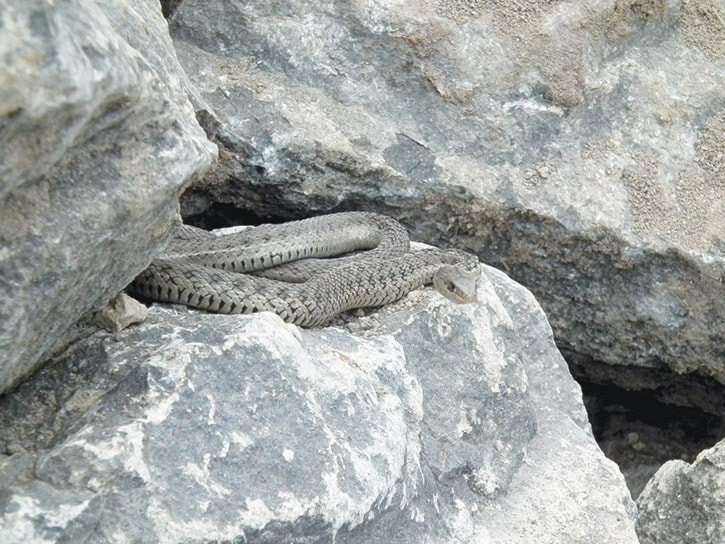Approximately 200 garter snakes are hunkering down for the winter in a new den after workers at the Highway 97 four-laning project near Sugar Cane uncovered their old one.
The snakes were first discovered on Oct. 11 in layers of shale infill when crews were pulling back road along a 50-metre stretch near the Pioneer Log Homes of B.C. work site, said Julie Steciw, wildlife biologist with the Ministry of Forests, Lands and Natural Resource Operations.
Larry Davis from Cantex, the highway project’s contractor, contacted the Ministry of Transportation and Infrastructure about the snakes initially, Steciw said.
Then wildlife biologist Becky Cadsand and a BCCF contractor Carla Grimson, with help from workers on site, caught the snakes by hand.
They placed them in bins where they were stored until a new hibernaculum — an abode for creatures to survive the winter — was created for the snakes further away from the original site on the same side of the highway.
“I talked with wildlife biologist Mike Sarell of Ophiuchus Consulting based out of Oliver, who has lots of experience with snakes, and our provincial herpetologist specialist Punima Govindarajulu about what to do,” Steciw said. “Then habitat biologist Becky Bings and I approached the contractor and said let’s build something now and not wait for the spring because the spring is pretty critical. That’s when they breed and we did not want them stuck in a bin all winter.”
Davis put together a proposal to the Ministry of Transportation and Infrastructure to pay for the work.
Once it was approved, Steciw, Bings and Cantex got the materials they needed to start the construction.
They worked with Cantex and the ministry on the logistics and den design. Using boulders, they built the hibernaculum.
It is four metres in length and about three to four metres in width, with a height of one metre and a half and located further west.
“We put a fabric over top of that and the soil that was removed to create the depression was put on top so that we had additionally more than three feet of material to insulate it so there’s no frost below that point,” Steciw said. “We couldn’t put it where we wanted necessarily because there will be more construction in that area, so we put it where it will avoid construction and can be permanent.”
In the spring, Steciw will check on the snakes because at that time they should emerge from hibernation.
There were two types of garter snakes found at the site — Common and Western Terrestrial — which Steciw said is not unusual because a lot of these types of snakes cohabit in dens with other types of species.
Even though garter snakes are common, to find a significant den was a boon for the ministry because there are not that many dens identified in the region, she added.
“I am hoping that they get used to the new location. All they have to do is go down the hill like they did before to access the lake habitat. They can go quite some distance from their hibernaculum and then however they come back in the fall and overwinter strictly for the winter,” Steciw said. “Thank you to Cantex and MOTI for their quick response and construction of the snake den.”
